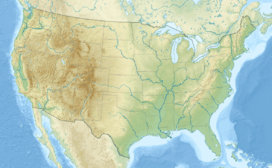Moccasin Gap facts for kids
Quick facts for kids Moccasin Gap |
|
|---|---|

Moccasin Gap in 2009
|
|
| Elevation | 1,266 ft (386 m) |
| Traversed by | Norfolk Southern Railway Big Moccasin Creek |
| Location | |
| Range | Clinch Mountain |
| Coordinates | 36°37′59″N 82°33′08″W / 36.6331557°N 82.5520975°W |
| Topo map | USGS Gate City |
Moccasin Gap, also called Big Moccasin Gap, is a natural opening in Clinch Mountain. This mountain is part of the huge Appalachian Mountains range. Moccasin Gap is found near Gate City, Virginia.
For a very long time, this gap has been an important path through the mountains. Native American tribes like the Cherokee and Shawnee used it. It was also the first gap that Daniel Boone's famous Wilderness Road went through. This road led towards the more well-known Cumberland Gap and into Kentucky. Today, Moccasin Gap is a main route for businesses, shops, and tourists.
Contents
Where is Moccasin Gap?
Moccasin Gap is one of only two natural openings in the Clinch Mountain ridge. It is located in Scott County, Virginia. The gap sits between two towns. Weber City is built on the south side of the gap. Gate City is located to the northwest.
How the Gap Was Formed
The land around Moccasin Gap is made of sedimentary rock. This rock formed from tiny bits of gravel, sand, and mud. These bits were pressed together over millions of years. This happened as shallow seas rose and fell a long time ago.
Moccasin Gap is a special type of gap called a water gap. This means a river or creek flows through it. Today, Big Moccasin Creek flows through the gap. This creek eventually joins the North Fork Holston River.
Weather in the Area
Scott County has a continental climate. This means it has four clear seasons. Summers are warm, with average temperatures around 77 degrees Fahrenheit (25 degrees Celsius). Winters are cooler, with averages around 36.5 degrees Fahrenheit (2.5 degrees Celsius). The most rain falls in summer and winter. The fall season usually has the least amount of rain.
History of Moccasin Gap
Moccasin Gap was a very important route through the mountains. The Cherokee and Shawnee tribes used it to reach their hunting grounds. These grounds were south of the Clinch River. Later, the gap was used as a way to attack settlers in the valleys. Soldiers also used it during the American Revolutionary War and the American Civil War.
Daniel Boone and the Wilderness Road
In 1775, a famous explorer named Daniel Boone helped build a road through the gap. He and 30 ax-men turned an old Native American path into a new road. This road was part of the famous Wilderness Road. It connected the Great Valley of Virginia to the Alleghenies.
Boone was on his way to the Kentucky River. This part of the Wilderness Road went north from the Long Island of the Holston River in Tennessee. It led towards the well-known Cumberland Gap. The Cumberland Gap is where Kentucky, Tennessee, and Virginia meet.
Growth and Development
The Wilderness Road brought many pioneer settlers and traders. They were looking for a way to travel to Kentucky and the west. Scott County and the nearby areas are thankful for the gap. It helped the region grow by becoming a key route for trade. Goods were moved to the Ohio River Valley.
Moccasin Gap is a fairly flat gap. This made it easy to build a railway through it. In 1886, the Southern Railway started using the gap. This connected its Appalachia and Holston Valley divisions.
Modern Changes
In 2006, the Virginia Department of Transportation began work on the roads in the gap. This included making US 23 wider. It also involved digging out parts of the gap. The first part of this project finished in July 2008. More phases are planned for the future. These plans will connect Route 72 to a bypass. This will change the natural shape of the mountain in the gap.


